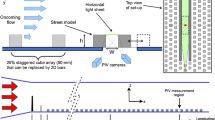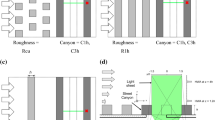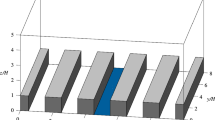Abstract
The characteristics of large- and small-scale turbulent motions at roof-level in a street canyon flow were experimentally investigated along with their spatio-temporal organization and their mutual interaction in this region. Quadrant analysis was conducted to identify sweep and ejection events, whilst a spanwise spatial filter was used to identify the large-scale motions in the flow. The present analysis was conducted for six configurations; three upstream roughness arrays and two canyon width (W) to height (h) aspect ratios (AR = W/h = 1 and 3). The upstream roughness arrays consisted of three-dimensional cubes (plan area density, λp = 25%), 1h spaced two-dimensional bars (λp = 50%, corresponding to the skimming-flow regime) and 3h spaced two-dimensional bars (λp = 25%, corresponding to the wake-interference flow regime). It was found that the roughness configuration has a strong effect on the size of the quadrant events in the street canyon, with the wake-interference flow regimes producing significantly larger sweep and ejection events than the skimming-flow regimes. Upstream wake-interference flow regimes were found to have a significantly greater temporal correlation than in the skimming-flow regimes. Large-scale streamwise and spanwise velocity components were found to have large spatio-temporal correlation integral scales, in agreement with the large-scale structures existing in the overlying boundary layer. It was also confirmed that there is a coupling between large- and small-scales at roof-level of the street canyon. While sweep and ejection events were found to be due to the dynamical contribution of the small-scales, their occurrence is shown to be coupled with that of large-scale low- and high-momentum regions, respectively.
















Similar content being viewed by others
References
Adrian RJ (2007) Hairpin vortex organization in wall turbulence. Phys Fluids 19:041301
Adrian RJ, Meinhart CD, Tomkins CD (2000) Vortex organization in the outer region of the turbulent boundary layer. J Fluid Mech 422:1–54
Ashcroft C, Zhang X (2005) Vortical structures over rectangular cavities at low speed. Phys Fluids 17:015104
Basley J, Perret L, Mathis R (2018) Spatial modulations of kinetic energy in the roughness sublayer. J Fluid Mech 850:584–610
Blackman K, Perret L (2016) Non-linear interactions in a boundary layer developing over an array of cubes using stochastic estimation. Phys Fluids 28:095108
Blackman K, Perret L, Savory E (2015) Effect of upstream flow regime on street canyon flow mean turbulence statistics. Environ Fluid Mech 15:823–849
Blackman K, Perret L, Savory E (2018) Effect of upstream flow regime and canyon upstream ratio on non-liner interactions between a street canyon flow and the overlying boundary layer. Bound Layer Meteorol 169(3):537–558
Cheng H, Castro IP (2002) Near wall flow over urban-like roughness. Bound Layer Meteorol 104:229–259
Cheng H, Hayden P, Robins JF, Castro IP (2006) Flow over cube arrays of different packing densities. J Wind Eng Ind Aerodyn 95(2007):715–740
Christen A, Van Gorsel A, Vogt R (2007) Coherent structures in urban roughness sublayer turbulence Int. J Climatol 27:1955–1968
Coceal O, Dobre A, Thomas TG, Belcher SE (2007) Structure of turbulent flow over regular arrays of cubical roughness. J Fluid Mech 589:375–409
Cui Z, Cai X, Baker CJ (2004) Large-eddy simulation of turbulent flow in a street canyon. Q J R Meteorol Soc 130(599):1373–1394
Hutchins N, Marusic I (2007) Evidence of very long meandering features in the logarithmic region of turbulent boundary layers. J Fluid Mech 579:1–28
Hutchins N, Monty JP, Ganapathisubramani B (2011) Three-dimensional conditional structure of a high-Reynolds- number turbulent boundary layer. J Fluid Mech 673:255–285
Inagaki A, Kanda M (2010) Organized structure of active turbulence over an array of cubes within the logarithmic layer of atmospheric flow. Bound Layer Meteorol 135:209–228
Jaroslawski T, Blackman K, Perret L, Savory E (2019) The spanwise variations of roof-level turbulence in a street canyon flow. Bound Layer Meteorol 170:373–394
Kanda M, Moriwaki R, Kasamatsu F (2004) Large-eddy simulation of turbulent organized structures within and above explicitly resolved cube arrays. Bound Layer Meteorol 112:343–368
Kellnerova R, Fuka V, Kukacka L, Uruba V, Janour Z (2013) On the quadrant analysis of the flow in a street canyon. EPJ Web Conf 45:01132
Mathis R, Marusic I, Hutchins N, Sreenivasan KR (2011) The relationship between the velocity skewness and the amplitude modulation of the small scale by the large scale in turbulent boundary layers. Phys Fluids 23 (12):121702
Michioka T, Sato A (2012) Effect of incoming turbulent structure on pollutant removal from two-dimensional street canyon. Bound Layer Meteorol 145(3):469–484
Michioka T, Takimoto H, Kanda M (2010) Large-eddy simulation for the mechanism of pollutant removal from a two-dimensional street canyon. Bound Layer Meteorol 138:195–213
Michioka T, Takimoto H, Sato A (2014) Large-eddy simulation of pollutant removal from a three-dimensional street canyon. Bound Layer Meteorol 150(2):259–275
Perret L, Kerhervé F (2019) Identification of very large scale structures in the boundary layer over large roughness elements. Exp Fluids 60:97
Perret L, Ruiz L (2013) SPIV Analysis of coherent structures in a vegetation canopy model flow. Coherent flow structures at the earth’s surface, Chapter 11, pp 161–174
Perret L, Savory E (2013) Large-scale structures over a single street canyon immersed in an urban-type boundary layer. Bound Layer Meteorol 148:111–131
Perret L, Blackman K, Savory E (2012) Combining wind-tunnel and field measurements of street-canyon flow via stochastic estimation. Bound Layer Meteorol 16:491–517
Reynolds R, Castro IP (2008) Measurements in an urban type boundary layer. Exp Fluids 45:141–156
Robinson SK (1991) Coherent motions in the turbulent boundary layer. Annu Rev Fluid Mech 32:519–571
Salizzoni P, Marro M, Soulhac L, Grosjean N, Perkins RJ (2011) Turbulent transfer between street canyons and the overlying atmospheric boundary layer. Bound Layer Meteorol 141(3):393–414
Savory E, Perret L, Rivet C (2013) Modelling considerations for examining the mean and unsteady flow in a simple urban-type street canyon. Meteorol Atmos Phys 121:1–16
Shaw RH, Brunet Y, Finnigan JJ, Raupach MR (1995) A wind tunnel study of air flow in waving wheat: two-point velocity statistics. Bound Layer Meteorol 76:349–376
Takimoto H, Sato A, Barlow JF, Moriwaki R, Inagaki A, Onomura S, Kanda M (2011) Particle image velocimetry measurements of turbulent flow within outdoor and indoor urban scale models and flushing motions in urban canopy layers. Bound Layer Meteorol 140(2):295–314
Takimoto H, Inagaki A, Kanda M, Sato A, Michioka T (2013) Length-scale similarity of turbulent organized structures over surfaces with different roughness types. Bound Layer Meteorol 147(2):217–230
Tomkins CD, Adrian RJ (2003) Spanwise structure and scale growth in turbulent boundary layers. J Fluid Mech 490:37–74
Wang H, George W (2001) The integral length scale homogeneous isotropic turbulence. J Fluid Mech 459(429):453
Acknowledgements
The authors would like to thank Mr. Thibaut Piquet for his technical support during the experimental program, Dr. Karin Blackman the Douglas Muzyka Scholarship (The University of Western Ontario, Canada) and the Natural Sciences and Engineering Research Council (NSERC) of Canada for providing funding. Financial support of the French National Research Agency through the research Grant URBANTURB No. ANR-14-CE22-0012-01 is also acknowledged.
Author information
Authors and Affiliations
Corresponding author
Additional information
Publisher's Note
Springer Nature remains neutral with regard to jurisdictional claims in published maps and institutional affiliations.
Rights and permissions
About this article
Cite this article
Jaroslawski, T., Savory, E. & Perret, L. Roof-level large- and small-scale coherent structures in a street canyon flow. Environ Fluid Mech 20, 739–763 (2020). https://doi.org/10.1007/s10652-019-09721-w
Received:
Accepted:
Published:
Issue Date:
DOI: https://doi.org/10.1007/s10652-019-09721-w




